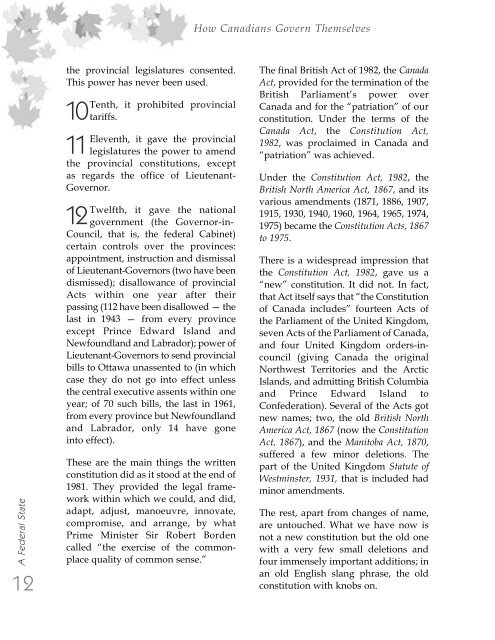How Canadians Govern Themselves - Parlement du Canada
How Canadians Govern Themselves - Parlement du Canada
How Canadians Govern Themselves - Parlement du Canada
Create successful ePaper yourself
Turn your PDF publications into a flip-book with our unique Google optimized e-Paper software.
<strong>How</strong> <strong>Canadians</strong> <strong>Govern</strong> <strong>Themselves</strong>A Federal State12the provincial legislatures consented.This power has never been used.1011Tenth, it prohibited provincialtariffs.Eleventh, it gave the provinciallegislatures the power to amendthe provincial constitutions, exceptas regards the office of Lieutenant-<strong>Govern</strong>or.12Twelfth, it gave the nationalgovernment (the <strong>Govern</strong>or-in-Council, that is, the federal Cabinet)certain controls over the provinces:appointment, instruction and dismissalof Lieutenant-<strong>Govern</strong>ors (two have beendismissed); disallowance of provincialActs within one year after theirpassing (112 have been disallowed — thelast in 1943 — from every provinceexcept Prince Edward Island andNewfoundland and Labrador); power ofLieutenant-<strong>Govern</strong>ors to send provincialbills to Ottawa unassented to (in whichcase they do not go into effect unlessthe central executive assents within oneyear; of 70 such bills, the last in 1961,from every province but Newfoundlandand Labrador, only 14 have goneinto effect).These are the main things the writtenconstitution did as it stood at the end of1981. They provided the legal frameworkwithin which we could, and did,adapt, adjust, manoeuvre, innovate,compromise, and arrange, by whatPrime Minister Sir Robert Bordencalled “the exercise of the commonplacequality of common sense.”The final British Act of 1982, the <strong>Canada</strong>Act, provided for the termination of theBritish Parliament’s power over<strong>Canada</strong> and for the “patriation” of ourconstitution. Under the terms of the<strong>Canada</strong> Act, the Constitution Act,1982, was proclaimed in <strong>Canada</strong> and“patriation” was achieved.Under the Constitution Act, 1982, theBritish North America Act, 1867, and itsvarious amendments (1871, 1886, 1907,1915, 1930, 1940, 1960, 1964, 1965, 1974,1975) became the Constitution Acts, 1867to 1975.There is a widespread impression thatthe Constitution Act, 1982, gave us a“new” constitution. It did not. In fact,that Act itself says that “the Constitutionof <strong>Canada</strong> includes” fourteen Acts ofthe Parliament of the United Kingdom,seven Acts of the Parliament of <strong>Canada</strong>,and four United Kingdom orders-incouncil(giving <strong>Canada</strong> the originalNorthwest Territories and the ArcticIslands, and admitting British Columbiaand Prince Edward Island toConfederation). Several of the Acts gotnew names; two, the old British NorthAmerica Act, 1867 (now the ConstitutionAct, 1867), and the Manitoba Act, 1870,suffered a few minor deletions. Thepart of the United Kingdom Statute ofWestminster, 1931, that is included hadminor amendments.The rest, apart from changes of name,are untouched. What we have now isnot a new constitution but the old onewith a very few small deletions andfour immensely important additions; inan old English slang phrase, the oldconstitution with knobs on.




